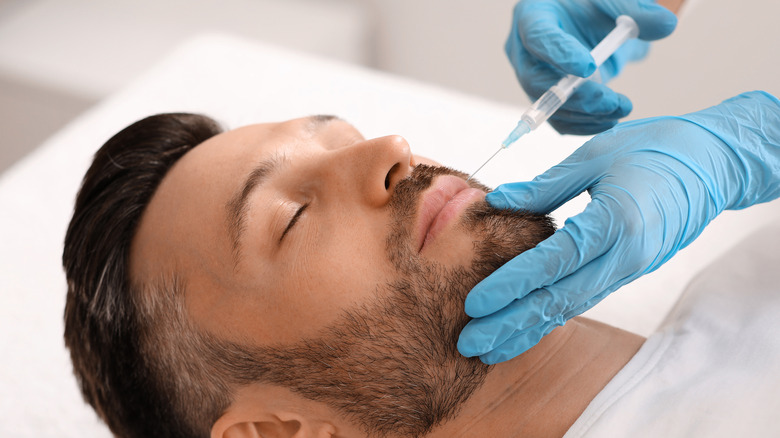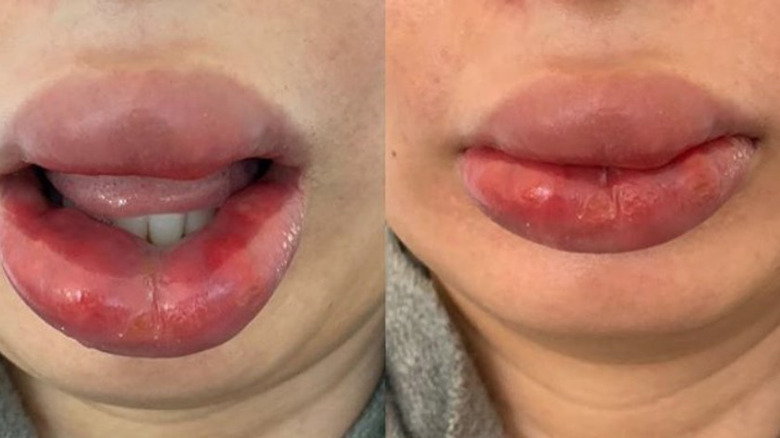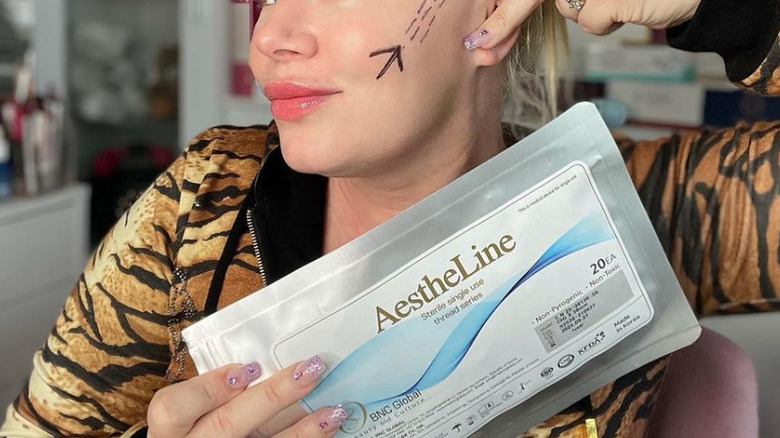The Risks Of Dermal Fillers May Outweigh The Benefits - Here's What You Should Know
It's simple to find yourself overcoming your dread of needles in your quest to stay young, looking for as many years as possible. Hundreds of products exist to help people obtain their beauty goals. Botox, chemical peels, and laser skin resurfacing are just a few drops in the bucket of cosmetic procedures to refresh your face. But one, in particular, has raised interest and some concern amongst medical providers.
According to the Cleveland Clinic, Dermal fillers, or soft tissue fillers, are injectables meant to add volume and fullness to the face. They are popularly used to fill in wrinkles. Doctors typically apply these fillers in areas around the mouth and eyes, though they can also be injected into the lips to achieve a plumped-up pout. Celebrities such as actress Kaley Cuoco have been open about receiving dermal filler to maintain their appearances. She admitted to getting fillers to smooth out a line in her neck.
What makes them so appealing are the instant results with nearly zero downtime, but there are several risks associated with dermal fillers that most people need to be aware of.
Black market fillers may sound tempting but you should steer clear
Hyaluronic acid is the most common substance found in dermal fillers. Human skin naturally contains Hyaluronic acid, which is why it's one of the safest filler options. The smoothed finish product typically lasts anywhere from six months to one year. Though temporary, fillers are costly. Juvederm, a popular brand of dermal fillers, can cost around $684 per syringe. Most patients need multiple needles, with some providers recommending up to 15 per session. With this procedure getting pricy rather quickly, black market injections can sound appealing to those on a tight budget.
Often, black market fillers promise results that last longer for a quarter of the price using liquid silicone. This product is not FDA-approved, yet people flock to it because of its low cost and versatility. Liquid silicone is commonly used on the face and buttocks to achieve similar curves seen on popular influencers. However, liquid silicone is extremely dangerous, as it can travel throughout the body and enter the bloodstream. R&B singer K. Michelle has spoken openly about her struggles to have her black-market silicone injections removed from her body after they began causing severe medical problems. Illegal injections have become so problematic that the FDA was forced to issue a warning in 2017, urging people to avoid them.
DIY Hyaluronic acid fillers are just as dangerous as black-market silicone
Even if you don't go the black-market liquid silicone route, injecting Hyaluronic acid fillers into yourself is equally dangerous. Several YouTube videos show viewers how to inject their noses and lips with the substance. A 2018 study published in the journal of Plastic Surgery found that even though injectors knew the risks involved, they proceeded to perform their own fillers. Hyaluronic acid is also extremely easy to get, with some private sellers listing them on sites like DHGate.
Manhattan cosmetic surgeon and skincare expert Dr. Lara Devgan told The Post that self-injecting is "one of the most dangerous and irresponsible trends" to date. Blockage of the blood vessels, blindness, bruising, and even death are just a few of the risks associated with self-injection.
Another significant danger with purchasing Hyaluronic acid off the web is that you can never be too sure about what you're getting. As a non-medical professional, you may not know the difference between liquid silicone and Hyaluronic acid. Even if the seller maintains the product's safety, you can not be 100% certain.
Hyaluronic acid dermal fillers administered by a licensed professional are relatively safe. However, no one is exempt from complications such as late allergic reactions, which can occur up to six weeks after receiving the fillers. As a rule of thumb, always consult with her primary care physician before undergoing any cosmetic procedure, surgical or non-surgical.


